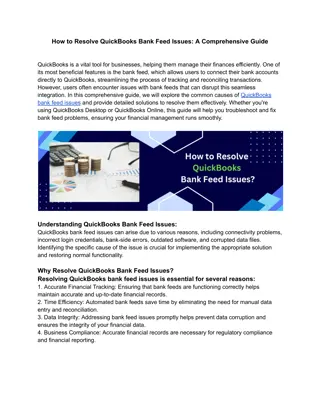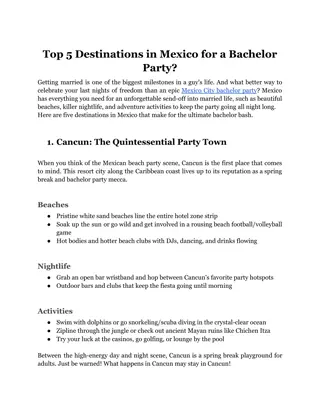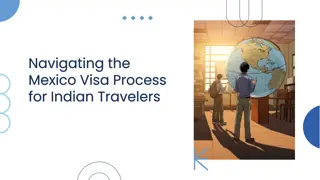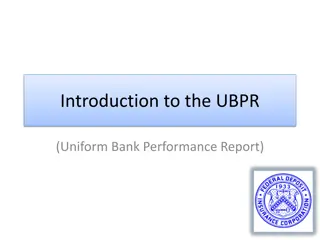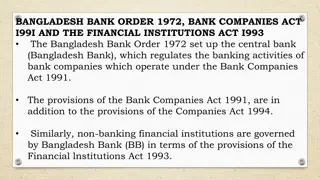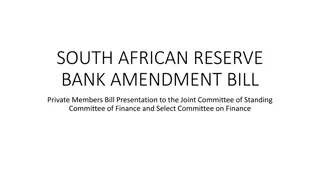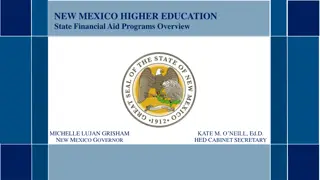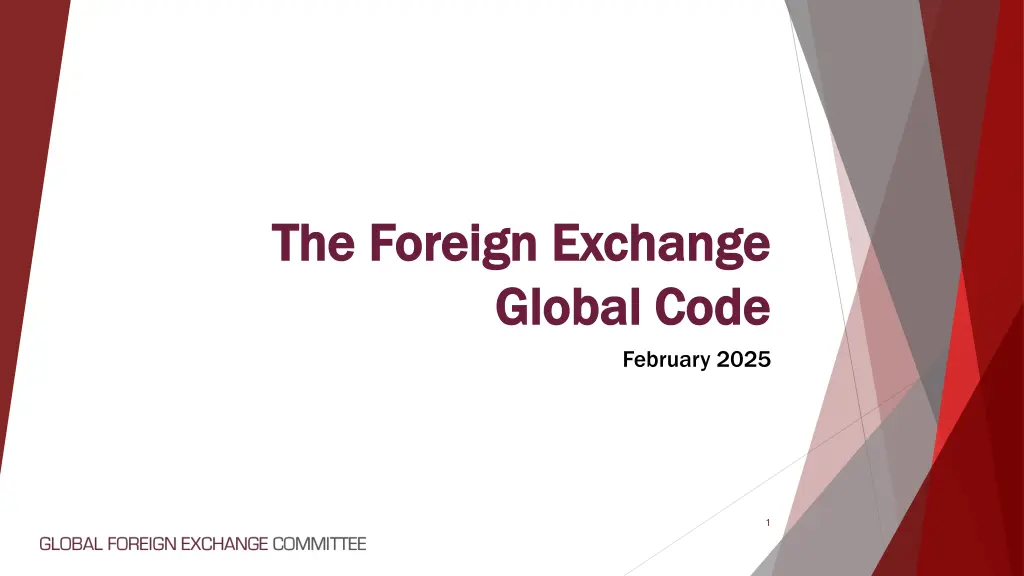
Foreign Exchange Global Code and GFXC Membership Overview
Explore the functions of the Global Foreign Exchange Code (Global Code) and the Global Foreign Exchange Committee (GFXC), including their objectives, membership criteria, and history. Discover the benefits of adopting the FX Global Code and the significance of collaboration between central banks and private sector participants in the FX market.
Download Presentation

Please find below an Image/Link to download the presentation.
The content on the website is provided AS IS for your information and personal use only. It may not be sold, licensed, or shared on other websites without obtaining consent from the author. If you encounter any issues during the download, it is possible that the publisher has removed the file from their server.
You are allowed to download the files provided on this website for personal or commercial use, subject to the condition that they are used lawfully. All files are the property of their respective owners.
The content on the website is provided AS IS for your information and personal use only. It may not be sold, licensed, or shared on other websites without obtaining consent from the author.
E N D
Presentation Transcript
The Foreign Exchange The Foreign Exchange Global Code Global Code February 2025 1
Agenda Agenda Background on the Global Foreign Exchange Committee (GFXC) and the FX Global Code Benefits of adopting the Code FX Global Code adoption Three-year review of the FX Global Code GFXC Working Groups 2025 Agenda 2
The GFXC The GFXC The GFXC was established in May 2017 as a forum, bringing together central banks and private sector participants. The objectives of the GFXC are: to promote collaboration and communication among the local FX committees (LFXCs) and non- GFXC jurisdictions with significant FX markets, to exchange views on trends and developments in global FX markets, including on the structure and functioning of those markets, drawing on information gathered at the various LFXCs, to promote, maintain and regular basis the FX Global Code and to consider good practices regarding effective mechanisms update on a to support adherence. 3
GFXC Membership GFXC Membership Members of the GFXC include central bank-sponsored LFXCs and similar structures. Members currently include: Full Members Associate Members Australia Euro Area Mexico South Korea Georgia Brazil Hong Kong Nordic Countries Switzerland Indonesia Canada India Singapore United Kingdom Israel China Japan South Africa United States 4
GFXC Membership GFXC Membership LFXCs may apply to join the GFXC as Full Members if they meet the following criteria: Be either (a) an established, central bank sponsored, LFXC or (b) a committee with a similar structure, which includes membership from both the relevant central bank and the private sector. Undertake to endorse and actively promote the Code. Have a minimum of 1% global FX turnover by currency, or sum of currencies, according to the latest BIS Triennial Survey of FX. LFXCs which meet some but not all of the Full Member criteria may be considered for participation in the GFXC as Associate Members. 5
History of the FX Global Code History of the FX Global Code A code of conduct FX Global Code 2021 2024 Background The FX market is largely unregulated Major shifts in market structure, transparency and regulatory focus in the aftermath of the Great Financial Crisis FX market misconduct investigations in 2013/14 The second three- year review was completed The FX Global Code was published in 2017 The Foreign Exchange Working Group (FXWG) worked towards developing an FX Code of Conduct, under the auspices of the BIS Markets Committee The first three-year review of the FX Global Code was completed The GFXC was launched in 2017 to bring together central banks and industry representatives to promote good practices in the FX market and maintain the Code FX Settlement Risk and the use of FX Data were the key focus areas Reports on Last Look and Pre-Hedging have been published g 6
The FX Global Code Principles The FX Global Code Principles Ethics Ethics Market Participants are expected to adhere to high ethical and professional standards to promote the fairness and integrity of the FX Market. Governance Governance Market Participants are expected to have sound and effective governance framework in place. This framework should provide clear responsibility and comprehensive oversight of their FX Market activity and promote responsible engagement in the FX Market. Execution Execution Market Participants are expected to exercise due care when negotiating and executing transactions in order to promote a robust, fair, open, liquid, and appropriately transparent FX Market. Information Information Sharing Sharing Market Participants are expected to ensure be clarity and accuracy in their communications and to protect Confidential Information to promote effective communication that fosters a robust, fair, open, liquid, and appropriately transparent FX Market. Risk Risk Management Management & Compliance & Compliance Market Participants are expected to promote and maintain a robust control and compliance environment to effectively identify, manage, and report on the risks associated with their engagement in the FX Market. Confirmation Confirmation & Settlement & Settlement Market Participants are expected to implement robust, efficient, transparent, and risk-mitigating post-trade processes to ensure the predictable, smooth, and timely settlement of transactions in the FX Market. 7
Benefits of FX Global Code adoption Benefits of FX Global Code adoption Offers valuable understanding on key topics in the FX Market Signalling effect - sends a message that your institution is committed to conducting FX Market activities in a manner consistent with the Code Provides greater confidence that the FX Market is functioning appropriately and in a fair and efficient way Fosters a level playing field between buy-side and sell-side Allows firms to continuously improve and benchmark their internal policies and procedures Contribute to ongoing discussions at LFXCs on improving the FX Market 8
Adoption of the FX Global Code continues to increase Adoption of the FX Global Code continues to increase During 2024, 37 Statements of Commitment were included in the GFXC Global Index of Public Registers, reaching a total of 1,328 entries. Type of market participant admitted to the Global Index of Public Registers during 2024 Statements of Commitment in the Global Index of Public Registers 1,500 1,328 1,291 4 37 1,184 1,250 107 Bank 7 103 1,000 Broker/Investment adviser 6 750 Buy-side 5 500 2 E-trading platform 250 Non-bank liquidity provider 0 End 2022 End 2023 Up to date 1 Other 9
Adoption of the FX Global Code by institution Adoption of the FX Global Code by institution Banks hold the largest share of representation in the Global Index of Public Registers, followed by buy-side participants and brokers or investment advisers. Statements of Commitment in the Global Index of Public Registers Distribution by type of market participant 3%2%2% Bank (851) 4% Buy-Side (154) 5% Broker/Investment Adviser (105) 8% Central Bank (68) Other (52) 12% E-trading Platform (45) 64% Non-bank Liquidity Provider (29) Infrastructure/Technology Provider (24) 10
Roadmap to adopting the FX Global Code Roadmap to adopting the FX Global Code 11
Three Three- -year review of the FX Global Code (2024) year review of the FX Global Code (2024) The GFXC identified several key areas for review to ensure that the Code continues to provide appropriate guidance and contributes to an effectively functioning FX market and remains in step with its evolution. The 2024 Code amendments focus on five of the Code s fifty-five principles (P9, P10, P35, P50, and P51), and the Disclosure Cover Sheets for Liquidity Providers and Platforms. The modifications were designed to improve guidance on FX Settlement Risk mitigation practices, and to enhance transparency around certain types of execution activity and on the utilisation of FX data. The amendments also include the addition of new illustrative examples, glossary entries and a modification to the Foreword section of the Code to include the links to existing GFXC reports, which were developed to provide further clarity on certain topics. 12
GFXC Working Groups GFXC Working Groups 2025 Agenda 2025 Agenda Motivation for Adherence Working Group FX Settlement Risk Working Group FX Data Working Group Promote greater knowledge sharing and increased visibility on the FX Global Code. The areas of focus are: Reduce FX settlement risk by encouraging the use of payment-versus-payment mechanisms. The areas of focus are: Analyse how the use of FX data can be made more transparent and evenly accessible to all market participants to improve market transparency and level the playing field. The areas of focus are: 1. Form partnerships with industry groups and rating agencies 2. Enhance Code education and training 3. Promote the Proportionality Assessment Tool and consider whether modifications are needed to the Disclosure Cover for some buy-side participants 1. Analyse the results of the LFXCs FX Settlement Survey 2. Analyse the results of the BIS Triennial Survey to assess the amount of FX Settlement Risk in the market and consider ways to mitigate it 3. Analyse the impact securities settlement on the FX Market 1. Discuss the availability and use of reference data transactions, with a focus on swaps Analyse the adoption of the updated Disclosure Cover Sheets for Liquidity Providers and Platforms Self- for derivatives 2. of accelerated 13
Contact Information Contact Information For additional details on the GFXC and the FX Global Code, please visit the GFXC website For general information about the Global Foreign Exchange committee: email@globalfxc.org For media enquiries: media@globalfxc.org 14









